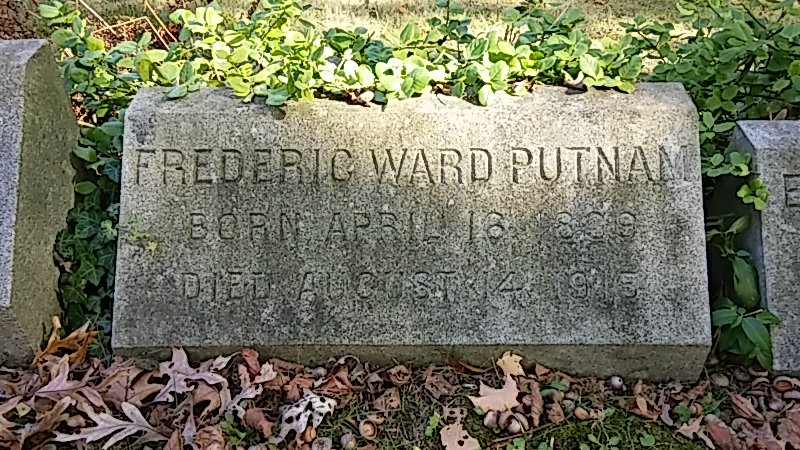
Frederic Ward Putnam (1839-1915)
Anthropologist, Archaeologist, & Biologist
An anthropologist and archaeologist, Frederic Ward Putnam was born in Salem, Massachusetts on April 16, 1839.
A descendant of the Putnam family, who arrived in Massachusetts in 1640, Putnam enjoyed a home and private education in his youth. By the age of sixteen, his interest in birds led to a curator position in the ornithology department of the Essex Institute. He entered Harvard the following year, studying under Louis Agassiz; Putnam became Agassiz’s assistant in 1857 and kept the position for seven years. Under Agassiz’s mentorship, Putnam developed an interest in ichthyology, the study of fish, while working at Harvard’s Lawrence Scientific School.
Before the age of 30, Putnam was simultaneously curator of ichthyology at the Boston Society of Natural History, curator of vertebrates at the Essex Institute, and co-founded American Naturalist with former Agassiz students Alpheus Hyatt, Edward Sylvester Morse, and Alpheus Spring Packard, Jr. (Lot 2573 Rose Path). He edited the journal, which contained articles on evolution and biological issues, for the next seven years while assisting at Harvard’s Museum of Comparative Zoology and teaching vertebrate zoology at the Anderson School on Penikese Island. Putnam’s expertise in ichthyology led to an appointment as Massachusetts State Commisssioner of Fish and Game, a position that lasted nine years.
Putnam’s interests shifted from the natural history of animals to that of humans as he developed an interest in archaeology. As the new superintendent of Salem’s Museum of the East Indian Marine Society (later the Peabody Academy of Science) in 1867, he familiarized himself with artifacts from different cultures. Putnam assisted with the Kentucky Geological Survey in 1874 and became director of Harvard’s Peabody Museum of American Archaeology and Ethnology the following year. From 1876-79, he served as Chief of Anthropology, studying prehistoric ruins and pueblo villages of the Southwest, as part of the Wheeler Survey. The end of the project coincided with a personal tragedy for Putnam: Adelaide Martha Edmands, his wife of fifteen years and mother to his three children, died.
In 1885 Putnam was named Peabody Professor of American Archaeology & Ethnology, collecting artifacts, fundraising, and teaching courses. The success of the Peabody Museum as an anthropological force was largely due to Putnam’s leadership. The 1885 Peabody Museum acquisition of Ohio’s Serpent Mound, thanks to Putnam’s appeal to the museum’s trustees and members of the Archaeological Institute of America (including Francis Parkman and Martin Brimmer [Lot 394 Indian Ridge Path]), is considered to be one of the first archaeological preservation projects in the United States.
A recommendation for an anthropological exhibit at the World Colombian Exposition (in a letter written to the Chicago Tribune) led to Putnam’s appointment as Chief of the Department of Anthropology at the Exposition between 1891-94. He helped collect artifacts for an ethnological exhibit with the assistance of the Smithsonian Institute and anthropologist Franz Boaz; these artifacts formed the foundations of the Chicago Field Museum’s anthropological collections. Putnam went on to co-found his own anthropology department at the American Museum of Natural History in New York City in 1893, doubling the collection and establishing the framework of the department’s research, exploration, and publication activities for the next ten years. At the age of 64, he became the first professor of Anthropology and director of the Anthropological Museum of the University of California.
Putnam retired from California in 1909 and maintained his work with Harvard and the Peabody Museum. He was named Professor Emeritus in 1910 and became Honorary Curator of the Peabody Museum upon retirement. Over the course of his career, Putnam published over 400 papers and received many honors and memberships from institutions around the world.

Putnam died in August of 1915, and was buried with his wives and daughters in Lot 4574 on Oxalis Path in Mount Auburn.
Footnotes:
Adapted from the research of Jill Graboski, as published in Mount Auburn’s April Birthday: Frederic Ward Putnam, 2004.
